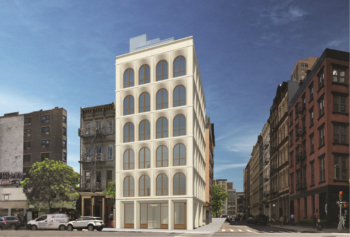
Modified design of 31 Lispenard Street./Image Credit: GF55 Architects and Urban Standard Capital
The modified design addressed concerns raised at the Landmarks public hearing. On November 12, 2019, the Landmarks Preservation Commission voted to approve a certificate of appropriateness to demolish an existing one and a half-story commercial brick building and construct a new seven-story residential and commercial use building with an elevated mechanical bulkhead at 31 Lispenard Street, Manhattan. At the September 17th public hearing, Landmarks had concerns about the proposed design and asked the applicants to make modifications. For CityLand’s prior coverage, click here.

Original design for 31 Lispenard Street/Image Credit: GF55 and Urban Standard Capital
The original design was presented at the September 17th Landmarks public hearing. Initially, the applicants proposed to construct a seven-story tall building which rose to a height of 85 feet, with an additional ten feet for its mechanical bulkhead. There was a penthouse with a gray façade on the seventh floor of the building. The building’s front façade was made out of white pre-cast concrete and characterized by recessed, arched windows that spanned across each story. A horizontal band divided each story on the façade. A cornice made of recast concrete lined the top of the building.
Landmarks raised concerns that the building’s front façade looks more modern and dominant than the surrounding buildings, the bulkhead is too tall, and the rear façade should be brick instead of eifs cladding.
At the November 12 public hearing, David Gross of GF55 Architects presented the modified design for the building. In the modified design, the front façade’s color was toned down and changed from white to limestone. The horizontal bands were replaced with horizontal reveals carved into the building. David Gross stated that the framing of the building was changed to have more symmetry and the height of the building’s base was increased to make the building appear wider at the base. The bulkhead was lowered by one foot and eight inches. Architectural details were removed from the penthouse floor to make it appear softer and less dominant. The color of the penthouse floor and the bulkhead were changed to match the overall building’s color. The cornice was extended out past the property line to reduce the visibility of the penthouse floor and the bulkhead. The rear façade’s material was changed from eifs cladding to brick.
Landmarks voted to approve the certificate of appropriateness based on its modified design. Landmarks Chair Sarah Carroll noted that the modifications addressed Landmarks’ concerns with the original design.
By: May Vutrapongvatana (May is the CityLaw Fellow and New York Law School Graduate, Class of 2019).

